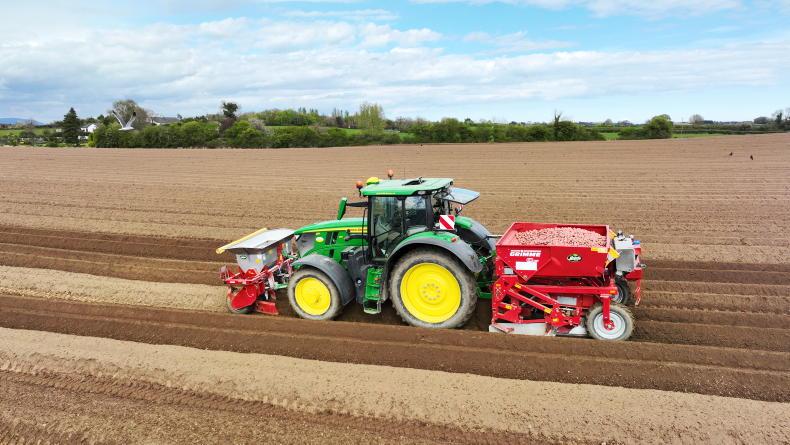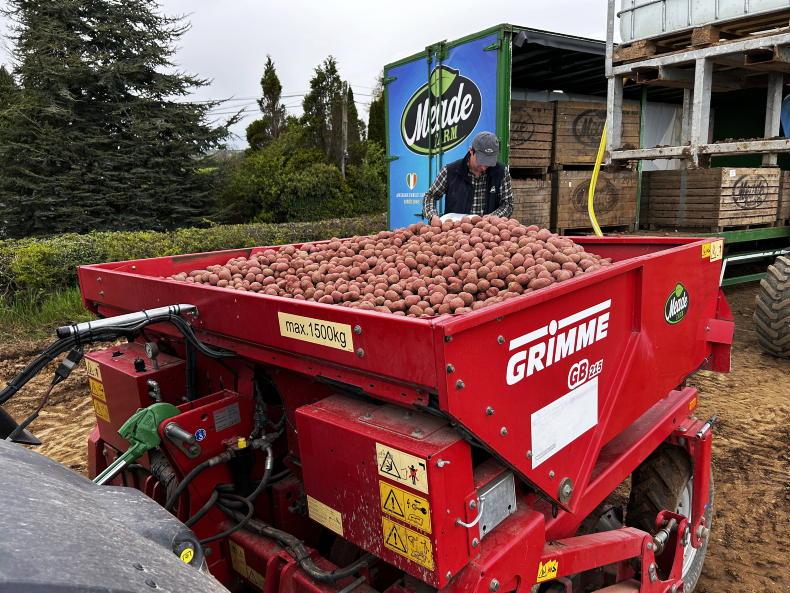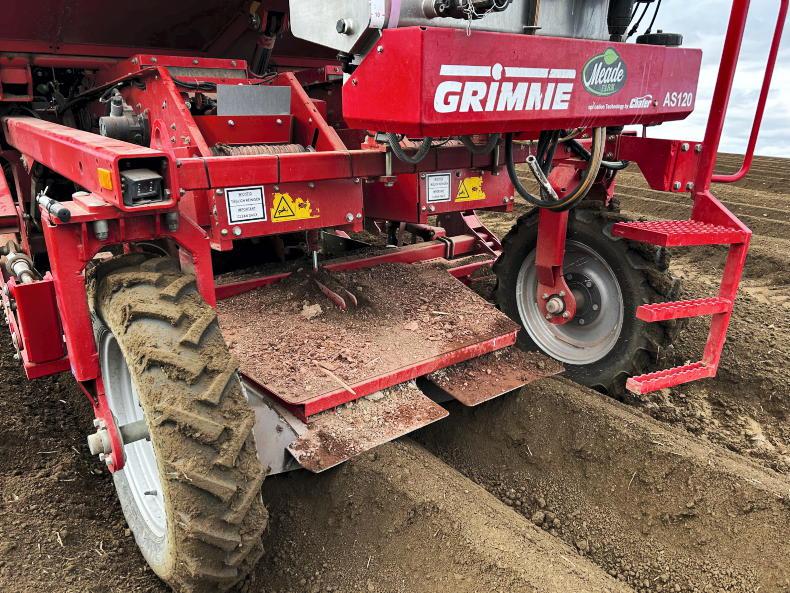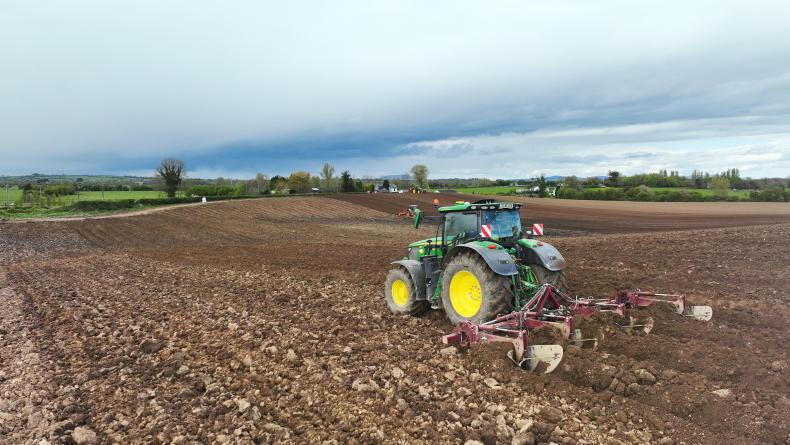Located in the heart of the Boyne Valley, Meade Farm has grown over the decades to become one of Ireland’s largest packers and distributors of fruit and vegetables, supplying all of Ireland’s major retail chains.
Alongside this, the firm runs a mixed farming enterprise which includes growing over 1,000 acres of crops.
We caught up with Robert Devlin, executive director, and Daniel Williams, tillage farm manager for the potato division, while planting Maris Pipers destined for the packing market.

Meade's Grimme GB 215 planter is now in its seventh working season and has planted in the region of 3,200 acres.
When we visited, Robert estimated that planting was about three weeks to one month behind previous years, at which point only 50ac had been planted compared to 150ac most years.
With that said, Robert pointed out that the delayed planting of early crops has now had knock-on effect with the main crops. To further improve capacity and throughput when the weather windows do arrive, it was decided this year to run two planting teams, one looking after potatoes and the second looking after carrots.

Left to right: Robert Devlin, Philip Meade Sr and Daniel Williams.
To do this, a third Grimme CS150 destoner was added to the heavily John Deere and Grimme themed fleet of machinery. One destoner remains with each team, while the third drifts between the two, depending on where it is needed.
When it comes to planting such acreages of root crops, the Meades need to run an efficient high-throughput system given the degree of machinery and operators required. The intention is to plant all ground prepared on the day.

All land prepared for planting is planted that day.
Effectively, this means that the same ground is ridged, bed tilled, destoned and planted all within the working day. Ridging tends to take place within one to two days before planting.
For the past seven seasons, the Meades have planted all potatoes using a Grimme GB 215 two-row belt planter. To date, this machine has planted over 3,200 acres, relatively trouble-free. Prior to its existence, a Grimme cup-type planter was used.
However, the team is nearing a point where further planting capacity is required, mainly for two reasons. Firstly, to accommodate the annual increase in potato acreage. Secondly, to help overcome weather-related delays to the planting season when conditions do come right. Earlier planting results in earlier harvesting.

In ideal conditions up to 25 acres can be planted in a 15-hour working day using the two-row belt planter.
Two-row or four-row planting?
In recent years, some of the large growers in the country have made the switch to a four-row planter, effectively doubling planting capacity in the one pass, while using the one tractor and operator.
This greatly improves efficiencies and the work rate in the field, but also requires the move to a four-row harvester, leaving the move a substantial investment.
Daniel said: “With the current two-row machine we can plant up to 25 acres in a long day from 7am to 10pm, if conditions are right.
“Looking ahead, we have to either make the move to a four-row system or invest in a second two-row planter. There are positives and negatives for each.
“The benefits of a four-row system is that no additional tractors or operators are required.
“Half the travelling is done between drills, meaning less compaction and less diesel being burnt. However, the major downside – aside from the cost of changing the planter and harvester – is the overall width of the planter for transport.
“We farm multiple blocks of fragmented land, which would leave moving farms an additional challenge.
“A second two-row machine would be a lower initial investment considering we do have spare tractor.
“But at the same time, the requirement for an additional tractor and operator is a downside. On top of that, one loader at the headland would be at its limits keeping two planters working.”
For now, the team is leaning towards the decision of a second two-row machine that could potentially be pulled in and out of service as needs be.

For now, the team is leaning towards opting for a second two row belt planter.
Grimme GB 215
When we visited, the crew was working away in field on the outskirts of Ardee, Co Louth.
Seven tractors were involved between the preparation and planting process. This included one tractor further loosening the ploughed ground with a stubble cultivator, one tractor ridging, one tractor bed tilling, three tractors destoning and one tractor planting.
As already mentioned, Meade Farm runs a Grimme GB 215 planter. This is a mounted, two-row belt machine with a hopper capacity of 1.5t. It is equipped with a flow-board for bed planting. This year, Daniel is planting with a new John Deere 6R 195, which he describes as slightly overkill in terms of power but not so much weight.
While less than 100hp is adequate to work the planter theoretically, a tractor with a suitable lift capacity and weight is of more importance given the weight of the planter plus 1,500kg worth of tubers.

The most time-consuming part of planting is loading the hopper, spray tank and front fertiliser hopper.
Typically, Daniel plants at speeds between 5km/h and 7km/h and to a depth of 6in to 7in into the drills. Once in the bed, the only other requirement aside from the force needed to pull the planter is a 50l/min hydraulic requirement to operate the belts and hydraulic functions via load sensing.
Upfront, the Meades run a Grimme granular fertiliser applicator. This is a straightforward 500kg hopper that works via gravity and ground wheel drive system.
A double-disc setup on each side begins the furrow opening process and deposits fertiliser within the bed.

The front-mounted 500kg fertiliser hopper works mechanically via a ground-wheel-drive system.
The front ground wheels leave it so that it supports its own weight in the drills. Daniel finds that the front hopper balances the tractor well given the weight of the planter.

Finger feelers help control and sort the feed of potatoes from the feed belt on to the supply conveyor.
The planter further opens the furrow, which is then sprayed with a fungicide to minimise disease risk. Meanwhile, tubers start off in the main hopper before being fed out on to the feed belt. They are then sorted using finger feelers before making their way on to the round belt supply conveyor.

The flow-board is required when planting into beds as is common in Ireland.
At this point, tubers are sorted into single file before encountering a foam roller. Tuber flow needs to be set depending on seed size. Any doubling up of tubers or those that fall off are then returned back to the start of the supply conveyor via return belts.
The aim is to have a continuous row of tubers positioned tightly against one another on the rubber belts.

The central supply conveyor is made up of six round rubber belts with return conveyors on either side.
By the time the tuber encounters the foam roller, the bed has been fertilised, opened and sprayed.
The tubers then freefall into the bed. An ultrasonic sensor determines spacings which can be altered by adjusting the foam roller speed. Next up, a second nozzle on each row applies the planted tuber with fungicide.
By now, the tubers are covered with soil and the bed forming process finishes.
The ground wheel on the planter shuts on and off the plating process, as well as adjusting planting speed in accordance to forward speed. The 120l stainless steel spray tank is positioned at the rear of the seed hopper.

All settings in relation to the flow-board are adjusted manually.
Depending on the variety and seed size, the 1.5t hopper will contain enough seed potatoes to plant between 0.8ac and 1.2ac. Daniel has cameras setup so that seed flow on to the belts can be constantly monitored.
All functions from spraying to adjusting the hopper is done through the terminal inside the cab.
Isobus control is now an option on newer machines which Daniel feels would be a welcome addition, especially for calibrations between different seed sizes and varieties.
The most time-consuming art of planting is the frequent refilling of seed, spray and fertiliser. Daniel outlines that a good telehandler operator on the headland can decide how much work is done in a day. Similar to Formula 1 racing, these stops need to be quick.

From the cab, Daniel has full control over the planting process.
The Meades currently run three Grimme CS 150 Combi-Web destoners. These machines are configured with two rows of stars followed by two main webs.
Other Grimme kit includes a 9400 ridging hiller, a WV140 onion windrower, a 2023 GT170 trailed carrot harvester and a 2018 Varitron 220 self-propelled potato harvester.
“It’s costly equipment but, in fairness, you get what you pay for. In addition to the build quality, the service and support from Cecil and the team at Grimme Ireland is excellent. For this reason, we couldn’t look elsewhere,” said Robert.

A third Grimme CS150 destoner was bought this year in order to run two planting teams.
A similar enough approach is taken when it comes to the farm’s tractors. Nine John Deeres are currently working within the business. Although predominantly R series models, there is still a couple of 30 series and one 20 series model. This year, two 6R 195 models were bought.
“Again, it’s the same story with the tractors, it’s about performance and the service and support from Meath Farm Machinery.
“A 6R 215 is the largest tractor on the farm. We hire in a contractor with a larger tractor for bed tilling as we have no other use for a tractor in excess of 250hp the rest of the year,” Robert explained.

A John Deere 6R 215 and Scanstone ridger works ahead of the bed tiller.
Meade Farm was first established in the late 1970s by Philip Meade Sr, starting out at the very location where the company headquarters is today in Lobinstown, Co Meath.
Philip started out growing potatoes as well as sourcing fruit and vegetables for the nearby and Dublin markets.

The Meades run three Grimme CS150 Multi-Web destoners.
As shoppers shifted to buying from supermarkets, Philip began supplying some of the major retailers at the time. Since then, the business has expanded year on year and now employs over 400 staff.
Suppliers
Alongside its own crops, Meade Farm has a long list of countrywide and global suppliers for all fruit and vegetables.
Today, the business is very much family-run. Philip Sr’s sons, Philip Jr and Patrick, along with his daughter, Eleanor, are all involved in the management of the business.
Divisions
The farm is broken down into tillage, horticulture, dairy/livestock and forestry divisions.
Broadly speaking, the large land base is divided into 300ac of potatoes, 100ac of carrots, 50ac of onions followed by 100ac of organic root crops and 100ac of brassicas.
Alongside this, the farm grows 350 acres of cereals and are in their third year milking 135 Fleckvieh cows using two Lely Astronaut robots on a grass-based system. Further adding to the farm’s diversity, there is also 40ac of forestry.
Model: GB 215.Number of rows: two.Seed capacity: 1,500kg.Hydraulic requirement: 50l/min.Required tractor: minimum 68hp.Daily acreage: 25 acres (maximum).
Located in the heart of the Boyne Valley, Meade Farm has grown over the decades to become one of Ireland’s largest packers and distributors of fruit and vegetables, supplying all of Ireland’s major retail chains.
Alongside this, the firm runs a mixed farming enterprise which includes growing over 1,000 acres of crops.
We caught up with Robert Devlin, executive director, and Daniel Williams, tillage farm manager for the potato division, while planting Maris Pipers destined for the packing market.

Meade's Grimme GB 215 planter is now in its seventh working season and has planted in the region of 3,200 acres.
When we visited, Robert estimated that planting was about three weeks to one month behind previous years, at which point only 50ac had been planted compared to 150ac most years.
With that said, Robert pointed out that the delayed planting of early crops has now had knock-on effect with the main crops. To further improve capacity and throughput when the weather windows do arrive, it was decided this year to run two planting teams, one looking after potatoes and the second looking after carrots.

Left to right: Robert Devlin, Philip Meade Sr and Daniel Williams.
To do this, a third Grimme CS150 destoner was added to the heavily John Deere and Grimme themed fleet of machinery. One destoner remains with each team, while the third drifts between the two, depending on where it is needed.
When it comes to planting such acreages of root crops, the Meades need to run an efficient high-throughput system given the degree of machinery and operators required. The intention is to plant all ground prepared on the day.

All land prepared for planting is planted that day.
Effectively, this means that the same ground is ridged, bed tilled, destoned and planted all within the working day. Ridging tends to take place within one to two days before planting.
For the past seven seasons, the Meades have planted all potatoes using a Grimme GB 215 two-row belt planter. To date, this machine has planted over 3,200 acres, relatively trouble-free. Prior to its existence, a Grimme cup-type planter was used.
However, the team is nearing a point where further planting capacity is required, mainly for two reasons. Firstly, to accommodate the annual increase in potato acreage. Secondly, to help overcome weather-related delays to the planting season when conditions do come right. Earlier planting results in earlier harvesting.

In ideal conditions up to 25 acres can be planted in a 15-hour working day using the two-row belt planter.
Two-row or four-row planting?
In recent years, some of the large growers in the country have made the switch to a four-row planter, effectively doubling planting capacity in the one pass, while using the one tractor and operator.
This greatly improves efficiencies and the work rate in the field, but also requires the move to a four-row harvester, leaving the move a substantial investment.
Daniel said: “With the current two-row machine we can plant up to 25 acres in a long day from 7am to 10pm, if conditions are right.
“Looking ahead, we have to either make the move to a four-row system or invest in a second two-row planter. There are positives and negatives for each.
“The benefits of a four-row system is that no additional tractors or operators are required.
“Half the travelling is done between drills, meaning less compaction and less diesel being burnt. However, the major downside – aside from the cost of changing the planter and harvester – is the overall width of the planter for transport.
“We farm multiple blocks of fragmented land, which would leave moving farms an additional challenge.
“A second two-row machine would be a lower initial investment considering we do have spare tractor.
“But at the same time, the requirement for an additional tractor and operator is a downside. On top of that, one loader at the headland would be at its limits keeping two planters working.”
For now, the team is leaning towards the decision of a second two-row machine that could potentially be pulled in and out of service as needs be.

For now, the team is leaning towards opting for a second two row belt planter.
Grimme GB 215
When we visited, the crew was working away in field on the outskirts of Ardee, Co Louth.
Seven tractors were involved between the preparation and planting process. This included one tractor further loosening the ploughed ground with a stubble cultivator, one tractor ridging, one tractor bed tilling, three tractors destoning and one tractor planting.
As already mentioned, Meade Farm runs a Grimme GB 215 planter. This is a mounted, two-row belt machine with a hopper capacity of 1.5t. It is equipped with a flow-board for bed planting. This year, Daniel is planting with a new John Deere 6R 195, which he describes as slightly overkill in terms of power but not so much weight.
While less than 100hp is adequate to work the planter theoretically, a tractor with a suitable lift capacity and weight is of more importance given the weight of the planter plus 1,500kg worth of tubers.

The most time-consuming part of planting is loading the hopper, spray tank and front fertiliser hopper.
Typically, Daniel plants at speeds between 5km/h and 7km/h and to a depth of 6in to 7in into the drills. Once in the bed, the only other requirement aside from the force needed to pull the planter is a 50l/min hydraulic requirement to operate the belts and hydraulic functions via load sensing.
Upfront, the Meades run a Grimme granular fertiliser applicator. This is a straightforward 500kg hopper that works via gravity and ground wheel drive system.
A double-disc setup on each side begins the furrow opening process and deposits fertiliser within the bed.

The front-mounted 500kg fertiliser hopper works mechanically via a ground-wheel-drive system.
The front ground wheels leave it so that it supports its own weight in the drills. Daniel finds that the front hopper balances the tractor well given the weight of the planter.

Finger feelers help control and sort the feed of potatoes from the feed belt on to the supply conveyor.
The planter further opens the furrow, which is then sprayed with a fungicide to minimise disease risk. Meanwhile, tubers start off in the main hopper before being fed out on to the feed belt. They are then sorted using finger feelers before making their way on to the round belt supply conveyor.

The flow-board is required when planting into beds as is common in Ireland.
At this point, tubers are sorted into single file before encountering a foam roller. Tuber flow needs to be set depending on seed size. Any doubling up of tubers or those that fall off are then returned back to the start of the supply conveyor via return belts.
The aim is to have a continuous row of tubers positioned tightly against one another on the rubber belts.

The central supply conveyor is made up of six round rubber belts with return conveyors on either side.
By the time the tuber encounters the foam roller, the bed has been fertilised, opened and sprayed.
The tubers then freefall into the bed. An ultrasonic sensor determines spacings which can be altered by adjusting the foam roller speed. Next up, a second nozzle on each row applies the planted tuber with fungicide.
By now, the tubers are covered with soil and the bed forming process finishes.
The ground wheel on the planter shuts on and off the plating process, as well as adjusting planting speed in accordance to forward speed. The 120l stainless steel spray tank is positioned at the rear of the seed hopper.

All settings in relation to the flow-board are adjusted manually.
Depending on the variety and seed size, the 1.5t hopper will contain enough seed potatoes to plant between 0.8ac and 1.2ac. Daniel has cameras setup so that seed flow on to the belts can be constantly monitored.
All functions from spraying to adjusting the hopper is done through the terminal inside the cab.
Isobus control is now an option on newer machines which Daniel feels would be a welcome addition, especially for calibrations between different seed sizes and varieties.
The most time-consuming art of planting is the frequent refilling of seed, spray and fertiliser. Daniel outlines that a good telehandler operator on the headland can decide how much work is done in a day. Similar to Formula 1 racing, these stops need to be quick.

From the cab, Daniel has full control over the planting process.
The Meades currently run three Grimme CS 150 Combi-Web destoners. These machines are configured with two rows of stars followed by two main webs.
Other Grimme kit includes a 9400 ridging hiller, a WV140 onion windrower, a 2023 GT170 trailed carrot harvester and a 2018 Varitron 220 self-propelled potato harvester.
“It’s costly equipment but, in fairness, you get what you pay for. In addition to the build quality, the service and support from Cecil and the team at Grimme Ireland is excellent. For this reason, we couldn’t look elsewhere,” said Robert.

A third Grimme CS150 destoner was bought this year in order to run two planting teams.
A similar enough approach is taken when it comes to the farm’s tractors. Nine John Deeres are currently working within the business. Although predominantly R series models, there is still a couple of 30 series and one 20 series model. This year, two 6R 195 models were bought.
“Again, it’s the same story with the tractors, it’s about performance and the service and support from Meath Farm Machinery.
“A 6R 215 is the largest tractor on the farm. We hire in a contractor with a larger tractor for bed tilling as we have no other use for a tractor in excess of 250hp the rest of the year,” Robert explained.

A John Deere 6R 215 and Scanstone ridger works ahead of the bed tiller.
Meade Farm was first established in the late 1970s by Philip Meade Sr, starting out at the very location where the company headquarters is today in Lobinstown, Co Meath.
Philip started out growing potatoes as well as sourcing fruit and vegetables for the nearby and Dublin markets.

The Meades run three Grimme CS150 Multi-Web destoners.
As shoppers shifted to buying from supermarkets, Philip began supplying some of the major retailers at the time. Since then, the business has expanded year on year and now employs over 400 staff.
Suppliers
Alongside its own crops, Meade Farm has a long list of countrywide and global suppliers for all fruit and vegetables.
Today, the business is very much family-run. Philip Sr’s sons, Philip Jr and Patrick, along with his daughter, Eleanor, are all involved in the management of the business.
Divisions
The farm is broken down into tillage, horticulture, dairy/livestock and forestry divisions.
Broadly speaking, the large land base is divided into 300ac of potatoes, 100ac of carrots, 50ac of onions followed by 100ac of organic root crops and 100ac of brassicas.
Alongside this, the farm grows 350 acres of cereals and are in their third year milking 135 Fleckvieh cows using two Lely Astronaut robots on a grass-based system. Further adding to the farm’s diversity, there is also 40ac of forestry.
Model: GB 215.Number of rows: two.Seed capacity: 1,500kg.Hydraulic requirement: 50l/min.Required tractor: minimum 68hp.Daily acreage: 25 acres (maximum). 




















 This is a subscriber-only article
This is a subscriber-only article













SHARING OPTIONS: